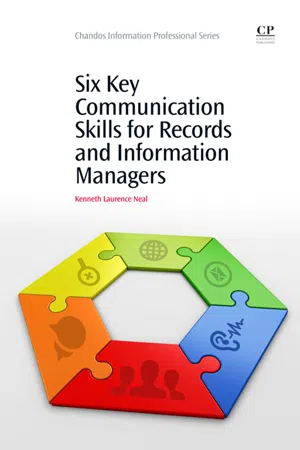
- 220 pages
- English
- ePUB (mobile friendly)
- Available on iOS & Android
Six Key Communication Skills for Records and Information Managers
About this book
Excellent business communication skills are especially important for information management professionals, particularly records managers, who have to communicate a complex idea: how an effective program can help the organization be better prepared for litigation, and do it in a way that is persuasive in order to win records program support and budget. Six Key Communication Skills for Records and Information Managers explores those skills that enable records and information to have a better chance of advancing their programs and their careers. Following an introduction from the author, this book will focus on six key communication skills: be brief, be clear, be receptive, be strategic, be credible and be persuasive. Honing these skills will enable readers to more effectively obtain support for strategic programs, communicate more effectively with senior management, IT personnel and staff, and master key forms of business communication including written, verbal and formal presentations. The final chapter will highlight one of the most practical applications of applying the skills for records and information managers: the business case. Based on real events, the business cases spotlighted involve executives who persuaded organizations to adopt new programs. These case histories bring to life many of the six keys to effective communication.- Addresses communication skills specifically for records and information managers while clarifying how these skills can also benefit professionals in any discipline- Includes case history examples of how communications skills made a difference in business and/or personal success- Focuses on written, verbal and presentation skills, where many books emphasize only one of these areas
Frequently asked questions
- Essential is ideal for learners and professionals who enjoy exploring a wide range of subjects. Access the Essential Library with 800,000+ trusted titles and best-sellers across business, personal growth, and the humanities. Includes unlimited reading time and Standard Read Aloud voice.
- Complete: Perfect for advanced learners and researchers needing full, unrestricted access. Unlock 1.4M+ books across hundreds of subjects, including academic and specialized titles. The Complete Plan also includes advanced features like Premium Read Aloud and Research Assistant.
Please note we cannot support devices running on iOS 13 and Android 7 or earlier. Learn more about using the app.
Information
Be brief: how brief?
Abstract
Guidelines for brevity
It’s not easy being brief
Make your writing more readable
| Publication | Flesch Readability Score |
| Comic books | 92 |
| Sports Illustrated magazine | 63 |
| Wall Street Journal | 43 |
| The IRS Tax Code | −6 |
Three best practices for being brief
1. Cut extraneous words
| Before | This year, after a careful fine-tuning of our records management budget, we were able to reduce our program costs by a grand total of $30,000 (26 words). |
| After | This year we saved $30,000 in records manageme... |
Table of contents
- Cover image
- Title page
- Table of Contents
- Copyright page
- Dedication
- List of tables
- List of abbreviations
- Acknowledgements
- About the author
- Introduction: why communication skills for records and information managers?
- 1: Be brief: how brief?
- 2: Be clear: is my proposal full of jargon?
- 3: Be receptive: am I asking questions and listening?
- 4: Be strategic: what am I trying to achieve?
- 5: Be credible: why should you believe me?
- 6: Be persuasive: are you persuaded yet?
- 7: Case histories: why should you adopt my business case?
- Conclusion: communicate as well as you can
- References
- Index